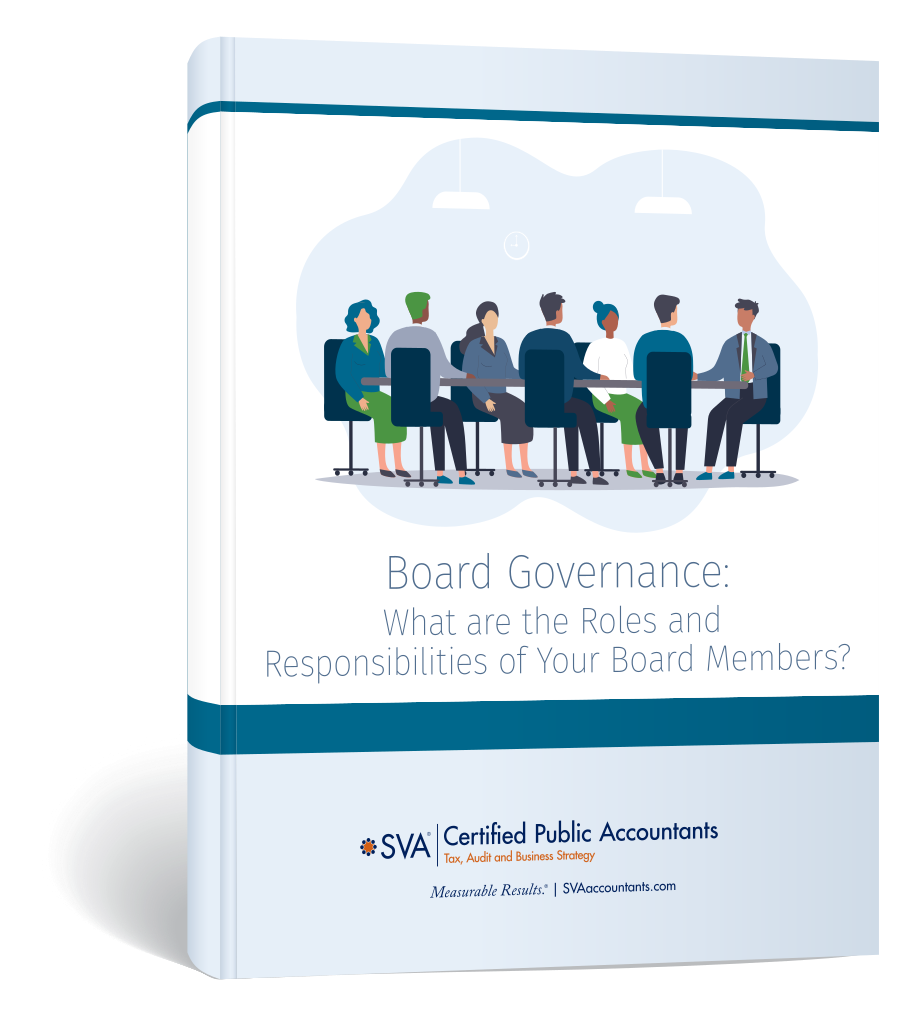Each nonprofit organization measures success differently. One thing they all have in common is the need for adequate resources for long-term sustainability. Developing an engaged board, creating effective fundraising campaigns, and ensuring compliance with routine reviews and audits are all part of running a nonprofit.
Executive directors and board leadership cannot do it all alone. That's why you should turn to professionals who provide specialized knowledge to define objectives, solve problems, and help you achieve your goals.

Business professionals need easy access to information to make timely decisions. SVA has what you need, when you need it. Choose a topic below or just contact us directly. Our expertise is ready anytime you need it.
Nonprofit organization leadership and boards of directors are continuously challenged to keep up with new tax laws, reporting requirements, and practice standards.
Our professionals provide various administration and governance resources to help you anticipate and prepare for new developments in nonprofit management.
Learn more about our Board Building Training Series.
Nonprofits who receive financial assistance from federal, state, or local government may be subject to audit requirements. Additionally, many states have charitable registration requirements that include the submission of an annual report based on the organization's revenue.
In Wisconsin, if a charitable organization receives contributions in excess of $500,000 during its fiscal year, an audit by an independent certified public accountant is required. If the annual contributions are over $200,000 but less than $500,000 a financial statement review, rather than an audit, is required.
SVA will help you determine your organization’s federal, state, and local audit requirements and guide you through the process.
BIZ TIP: Common Audit Challenges and Solutions for Nonprofit Organizations
SVA can help you with your reporting requirements to maintain your tax-exempt status. Each form has specific requirements on the information needed to verify and document your organization’s tax-exempt status.
Maintaining your tax-exempt status is vital and SVA will guide you through completion and submission of the correct form.
BIZ TIP: Filing Application for Tax Exemption - Form 1023 or 1023EZ
Excluding specific exceptions, federal law requires employee benefit plans with 100 or more participants (ERISA defined) include audited financial statements with the Form 5500 filing. Smaller plans may also require an audit if the plan does not meet certain conditions exempting it from the audit requirement.
SVA's auditors understand the complexities of employee benefit plans and can focus on the prominent issues, providing valuable guidance to you as the plan sponsor.
BIZ TIP: Changes Are Coming to Your Employee Benefit Plan Audit
ProfitCents is a powerful tool we use to generate projections and perform various “what-if” scenarios. Whether you're budgeting for growth, preparing projections for a loan, or acquiring a business, we use ProfitCents to generate detailed financial forecasts as well as benchmark your company’s performance against industry peers.
Thinking of purchasing new equipment or expanding operations? Our ROI analysis helps you evaluate whether the investment makes financial sense. We’ll help you understand the profitability of your investment and provide clear picture of your potential return and the timeline for reaching it.
The board of directors is responsible for hiring and establishing the compensation (salary and benefits) of the executive director/CEO by identifying reasonable compensation attractive enough to retain the best possible talent to lead the organization.
Nonprofits filing IRS Form 990 must describe the process they use to approve executive compensation as part of the nonprofit's annual return responses. The process starts with the board arranging for an independent body to review comparable salary and benefits data of organizations with relative size, geography, budget, and mission focus.
SVA can help with the process of determining and documenting your organization's executive compensation.
BIZ TIP: The Pros and Cons of Compensating Nonprofit Board Members
Governments at all levels – local, state, and federal – that hire nonprofits to deliver services are required to reimburse nonprofits for the reasonable indirect costs (sometimes called "overhead" or "administrative" costs) they incur on behalf of governments when federal dollars are part of the funding stream.
In addition, the OMB Uniform Guidance streamlines and clarifies cost allocation and other rules related to government grants and contracts, removing some areas of confusion and inconsistency while treating more of a nonprofit's expenses as direct (reimbursable) costs.
SVA will help you understand your obligations with the OMB Uniform Guidance.
BIZ TIP: Single Audit Requirements for Nonprofit Organizations That Receive Federal Funds
Tax-exempt organizations must file some version of Form 990 with the IRS each year to meet federal regulations. Private foundations must file Form 990-PF which includes disclosures of the foundation's assets, financial activities, trustees, officers, and a complete list of grants awarded during the year.
SVA will help you complete and file the required forms for your organization.
Handling all your payroll, tax preparation, and bookkeeping needs in-house requires staff who are experienced in these functions, as well as the continual updating of your accounting software. These are time-consuming tasks which can be easily outsourced to an experienced provider.
You can outsource as much or as little of the work and ensure there are adequate internal controls to avoid any risk of having the same people perform multiple duties.
Learn more at our client accounting services page.
BIZ TIP: 7 Benefits of Outsourced Accounting for Nonprofit Organizations
Understanding your break-even point is key to making confident business decisions. We can help you calculate how much you need to sell—daily, weekly, monthly, or annually—to cover your costs. You can use this analysis to better understand how to generate profits in your business.
Whether you’re launching a new product or simply reevaluating operations, our break-even analysis provides a granular look at the sales targets needed to keep your business on track.
We help companies design executive compensation plans that support strategic goals. From increasing profit margins to boosting sales performance, we work with leadership teams to build incentive programs that align with business objectives.
We also create easy-to-use templates that track performance metrics and compensation earned, providing a structured approach to rewarding results.

If your organizational structure includes a board of directors, you may be wondering “What are the roles and responsibilities of our board members?” Your questions are answered in this eGuide!
This eguide covers what an audit is and the different types of audits. It also contains checklists to help businesses prepare for an audit.
SVA offers a Six-Part Training Program that can be customized based on your organization's needs.
This Six-Part Training Program covers:
Basic Responsibilities
Legal Considerations
Overall Financial Considerations
Fundraising Responsibilities
The Board's Role in Mission, Planning, and Evaluation
Building and Leading the Board
These customizable training modules include training for the leadership team as well as the board members, real-life examples, sample forms and policies, and key takeaways from each session.
Services
Madison, WI
1221 John Q Hammons Dr, Suite 100
Madison, WI 53717
(608) 831-8181
Milwaukee, WI
18650 W. Corporate Drive, Suite 200
Brookfield, WI 53045
(262) 641-6888
Colorado Springs, CO
10855 Hidden Pool Heights, Suite 340
Colorado Springs, CO 80908
(719) 413-5551

Are you in the know on the latest business trends, tips, strategies, and tax implications? SVA’s Biz Tips are quick reads on timely information sent to you as soon as they are published.
Copyright © 2025 SVA Certified Public Accountants | Privacy Policy | Cookie Policy | CCPA